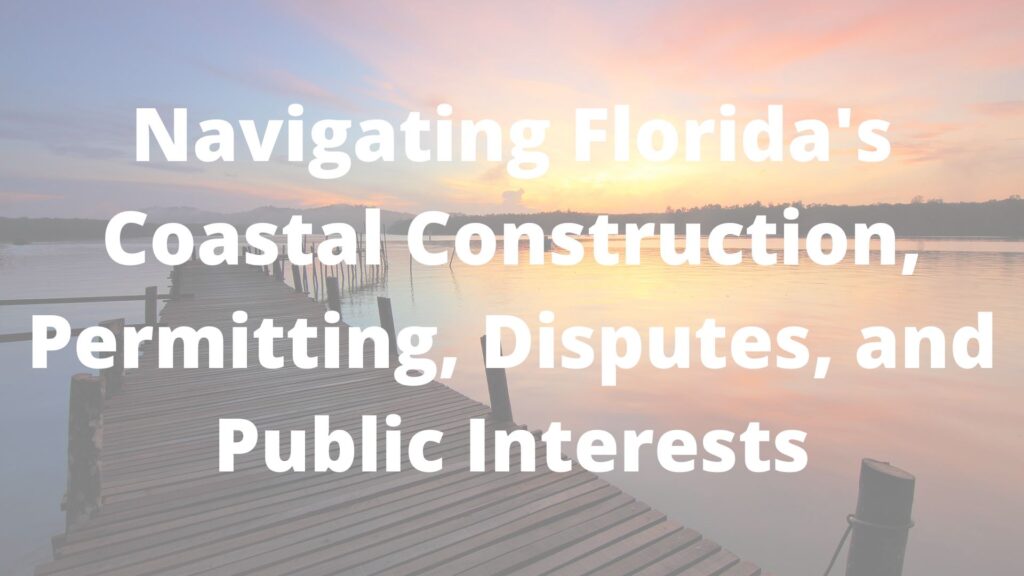
Florida, with its extensive coastline and burgeoning population, presents a unique confluence of development pressures and environmental sensitivities. For property owners and developers alike, understanding the intricate web of regulations governing coastal construction, particularly for structures like docks, piers, and seawalls, is paramount. This blog will delve into the complexities of coastal permitting in Florida and examine common legal battles stemming from marina construction and expansion.
Understanding Coastal Permitting for Docks, Piers, and Seawalls
The construction or modification of structures along Florida’s coastline, whether private docks, community piers, or protective seawalls, is subject to rigorous review by multiple state and federal agencies. The primary regulatory body at the state level is the Florida Department of Environmental Protection (FDEP), specifically through its Environmental Resource Permitting (ERP) program.
Key considerations for permitting include:
- Jurisdictional Delineation: The precise location of the proposed structure relative to the mean high water line, submerged lands, and sovereign submerged lands (owned by the state) dictates the specific permits required. Activities on sovereign submerged lands often necessitate a proprietary authorization from the FDEP, in addition to environmental permits.
- Environmental Resource Permits (ERPs): These permits, administered by the FDEP and, in some cases, delegated water management districts, evaluate potential impacts to wetlands, surface waters, and associated aquatic ecosystems. Considerations include water quality degradation, habitat destruction (e.g., seagrass beds, mangrove forests), and disruption of natural hydrological flow.
- Coastal Construction Control Line (CCCL) Permits: For structures located seaward of the CCCL, established by the FDEP to protect Florida’s beaches and dunes from improperly sited or designed structures, an additional permit is required. These permits focus on storm resiliency, erosion control, and protection of the public beach.
- Federal Consistency Review: Projects requiring federal permits, such as those from the U.S. Army Corps of Engineers (USACE) for work in navigable waters, must also undergo a federal consistency review to ensure alignment with the enforceable policies of Florida’s Coastal Management Program.
- Local Government Approvals: In addition to state and federal permits, local government comprehensive plans, zoning ordinances, and building codes must be satisfied. This often involves obtaining local development orders, building permits, and sometimes variances or special exceptions.
The permitting process is often extensive, requiring detailed engineering plans, environmental impact assessments, and public notice. Early consultation with regulatory agencies and experienced environmental consultants is crucial for successful project realization.
Disputes Over Marina Construction and Expansion
Marina projects, due to their scale and potential for significant environmental and community impacts, frequently become subjects of intense legal and public scrutiny. Common legal battles typically revolve around three main areas:
- Zoning and Land Use:
Disputes often arise when proposed marina developments or expansions conflict with existing local zoning ordinances or comprehensive plans. Residents and advocacy groups may challenge a project based on its incompatibility with the character of a neighborhood, its potential to increase traffic congestion, or its deviation from designated land use categories (e.g., residential versus commercial/industrial). Legal challenges often involve appeals of local government zoning decisions, petitions for certiorari, or lawsuits alleging “spot zoning” or inconsistencies with the adopted comprehensive plan.
- Environmental Impacts:
Environmental concerns form the bedrock of many marina disputes. Opponents frequently raise issues related to:
- Water Quality: Increased boat traffic, potential for fuel spills, and discharge of pollutants from maintenance activities can degrade water quality, impacting sensitive aquatic ecosystems and recreational uses.
- Habitat Destruction: Dredging for navigation channels, construction of docks and piers, and shoreline hardening can directly destroy or fragment critical habitats such as seagrass beds, oyster reefs, and mangrove forests, which serve as essential nurseries for marine life.
- Impacts on Protected Species: Projects in proximity to critical habitats for endangered or threatened species (e.g., manatees, sea turtles, smalltooth sawfish) face heightened scrutiny. Requirements for specific mitigation measures, such as manatee protection plans or seasonal construction windows, often become points of contention.
- Cumulative Impacts: Opponents may argue that while an individual project’s impact might seem minor, the cumulative effect of multiple developments in a sensitive area is detrimental, leading to a “death by a thousand cuts” scenario.
Legal challenges often involve appeals of FDEP or USACE permit decisions, alleging inadequate environmental review, failure to consider alternatives, or non-compliance with state and federal environmental statutes like the Florida Environmental Protection Act or the Clean Water Act.
- Public Access:
The issue of public access to Florida’s waterways is a constitutionally protected right and a frequent battleground in marina disputes. Opponents may argue that a proposed marina restricts public access to navigable waters, beaches, or creates an exclusive private domain that diminishes the public’s right to utilize these resources. This can manifest in challenges related to:
- Easements and Rights-of-Way: Disputes over the navigability of certain channels or the public’s right to traverse certain areas.
- Exclusion of Non-Motorized Vessels: Concerns that large-scale marina operations prioritize motorized vessel access at the expense of kayakers, paddleboarders, and other non-motorized users.
- Impact on Public Beaches: Marina structures can alter currents and sediment transport, potentially impacting public beaches and recreational opportunities.
Legal arguments often invoke the public trust doctrine, which asserts that sovereign submerged lands and navigable waters are held in trust by the state for the benefit of all citizens, ensuring their right to access and use these resources for navigation, fishing, and recreation.
Navigating coastal construction in Florida demands a comprehensive understanding of regulatory requirements and an awareness of potential legal challenges. While development is an economic driver, the state’s environmental integrity and the public’s right to access its natural resources must be meticulously balanced. Stakeholders, including property owners, developers, local governments, and environmental groups, must engage in transparent dialogue and adhere to robust regulatory frameworks to ensure responsible and sustainable coastal development for future generations.
 John Caravella Esq., is a construction attorney and formerly practicing project architect at The Law Office of John Caravella, P.C., representing architects, engineers, contractors, subcontractors, and owners in all phases of contract preparation, litigation, and arbitration across New York and Florida. He also serves as an arbitrator to the American Arbitration Association Construction Industry Panel. Mr. Caravella can be reached by email: [email protected] or (631) 608-1346.
John Caravella Esq., is a construction attorney and formerly practicing project architect at The Law Office of John Caravella, P.C., representing architects, engineers, contractors, subcontractors, and owners in all phases of contract preparation, litigation, and arbitration across New York and Florida. He also serves as an arbitrator to the American Arbitration Association Construction Industry Panel. Mr. Caravella can be reached by email: [email protected] or (631) 608-1346.
The information provided on this website does not, and is not intended to, constitute legal advice; instead, all information, content, and materials available on this site are for general informational purposes only. Readers of this website should contact their attorney to obtain advice with respect to any particular legal matter. No reader, user, or browser of this site should act or refrain from acting on the basis of information on this site without first seeking legal advice from counsel in the relevant jurisdiction. Only your individual attorney can provide assurances that the information contained herein – and your interpretation of it – is applicable or appropriate to your particular situation. Use of, and access to, this website or any of the links or resources contained within the site do not create an attorney-client relationship between the reader, user, or browser and website authors, contributors, contributing law firms, or committee members and their respective employers.
Resources
- Florida Department of Environmental Protection (FDEP): Environmental Resource Permitting, Coastal Construction Control Line, Submerged Lands and Environmental Resources Program.
- S. Army Corps of Engineers (USACE): Regulatory Program for permitting activities in waters of the U.S.
- Florida Statutes Chapter 161: Beach and Shore Preservation Act.
- Florida Statutes Chapter 373: Water Resources.
- Florida Administrative Code Title 62: Environmental Protection.
- Your Local Government’s Planning and Zoning Department: For comprehensive plans, zoning ordinances, and local permitting requirements.
